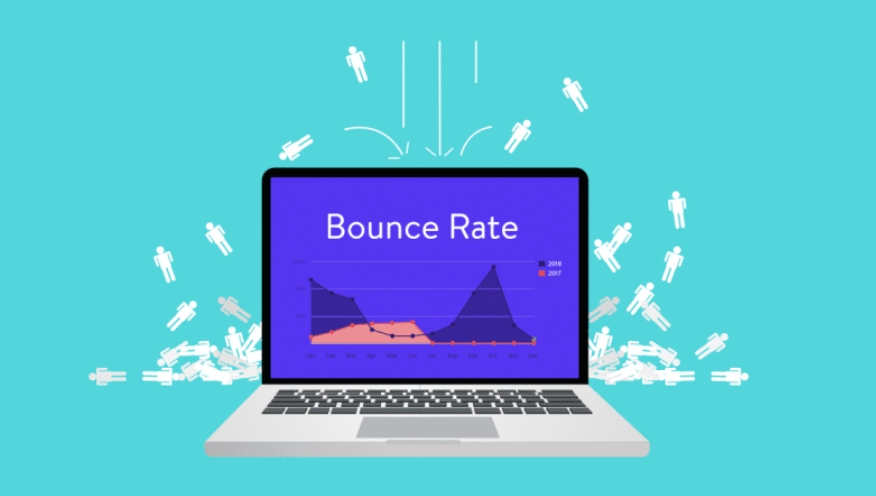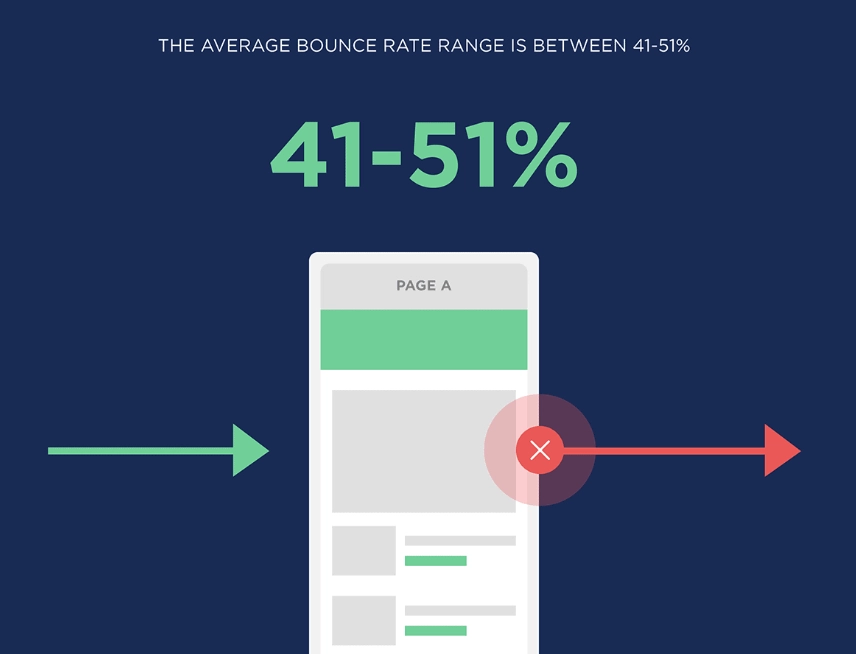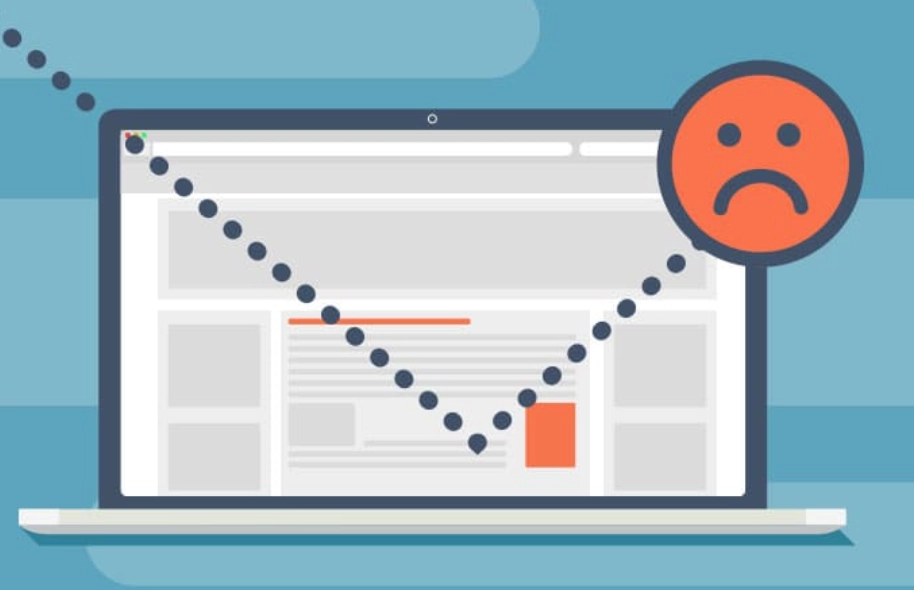What Is Bounce Rate?
Bounce rate is a term you’ll hear a lot if you’re looking at your website’s performance using tools like Google Analytics. It measures how many visitors come to your website and how many leave after seeing only one page. In simpler terms, if someone visits your site and exits without clicking to another page or interacting with your site in a meaningful way, that counts as a “bounce.”

Say you own an e-commerce site, and someone lands on your homepage. If they leave your site without browsing any product pages, making a purchase, or filling out a contact form, they have “bounced.” This would increase your website’s bounce rate. But bounce rate isn’t just a number; it tells you about user engagement and the effectiveness of your website.
For example, if you have a blog post about “How to make a Tiramisu,” and a user finds your post via a search result, reads the entire recipe, and then leaves, it still counts as a bounce. However, it might not necessarily be bad if the users get what they need. On the other hand, a high bounce rate on a landing page designed to convert visitors into customers could signal that your page isn’t appealing or relevant to what they expected based on your ad or search listing.
It’s important to understand that bounce rate is influenced by how visitors interact with your page. If you set up Google Analytics correctly, even if a visitor doesn’t go to another page but interacts with elements on the same page, like watching a video or using a tool, these can be configured not to count as bounces. This is why it’s essential to ensure your analytics setup accurately reflects visitor behavior and interactions, not just page exits.
Bounce Rate vs. Exit Rate
Bounce rate and exit rate are two metrics often used to analyze web traffic, but they tell different stories about how visitors interact with a website. Understanding the key differences between bounce rate and exit rate is essential for improving engagement rate and optimizing your site.
Bounce Rate
Say you have a blog about home gardening. Someone searches for “best flowers to plant in spring,” finds your article, opens it, and then immediately leaves your site without interacting further. This is a “bounce” because they visited only a single page and did not engage with other parts of your site. The bounce rate measures these single-page sessions divided by all sessions, showing how often people leave from the only page they visited on your site. High bounce rates can indicate that a web page might not be effectively engaging visitors or matching their search intent.
Exit Rate
Now, let’s say a visitor reads your article on spring flowers and then clicks on a link to a related post about gardening tools but decides to leave your site after reading the second article. This action contributes to the exit rate of the gardening tools page. The exit rate is calculated by dividing the number of exits by the total number of views for a particular page, giving you an idea of how frequently visitors leave that specific page after visiting other pages on your site.
While all bounces are exits, as both involve a visitor leaving, not all exits are bounces. A bounce occurs only when the visitor leaves after viewing just one page, i.e., their entry page. Meanwhile, an exit can occur after any number of pages are viewed. For example, if a visitor comes to your homepage, explores your About page, and then leaves, this will not increase your bounce rate but will affect the exit rate of the About page.
High exit rates on certain web pages might indicate where your content or offers need refinement to better retain visitors, whereas a high bounce rate across your site could suggest broader issues like poor page load speed, inadequate content relevance, or a suboptimal user experience on mobile devices.
What Is The “Average” Bounce Rate?
The “average” bounce rate can be difficult to measure because it highly depends on the type of website and the industry. Generally, the average bounce rate falls between 41% and 51%. However, this range can vary significantly based on the nature of the website and where the traffic originates.

For example, e-commerce sites often see lower bounce rates, generally ranging from 20% to 45%. This is because these sites are designed to engage visitors with various product listings and encourage multiple page views per session. On the other hand, the average bounce rate for blogs is much higher, sometimes as high as 90%. This is due to the nature of blog content, which often satisfies a visitor’s search intent on the first page they land on.
Traffic sources also play a major role in influencing average bounce rates. For example, traffic coming from emails and direct referrals tends to have a low bounce rate. These sources usually involve users who have a specific interest in or familiarity with the content. Conversely, traffic from display ads and social media accounts is known to have higher bounce rates, likely because this traffic is less targeted and users may not have a pre-existing interest in the site.
Why Is Bounce Rate Important?
Bounce rate is an important metric to understand how engaging and user-friendly your website is. As stated earlier, it reflects the percentage of visitors who land on your site and leave without viewing more than one page. A high bounce rate often indicates that your site’s landing pages aren’t capturing visitor interest, leading to quick exits, which can negatively impact your site’s conversion rates and overall user experience.
If visitors don’t stay on your site, they’re less likely to convert into customers or follow through on actions like signing up for newsletters or making purchases. This can lead to lower sales and decreased effectiveness of your online marketing efforts.
Does Bounce Rate Affect SEO?
While bounce rate isn’t directly labeled as a Google ranking factor, it holds significant indirect implications for Search Engine Optimization (SEO). Google has consistently stated that bounce rate does not directly influence your search rankings. However, a high bounce rate often flags potential issues that do affect SEO. Let’s explore why and how it influences SEO.
Associated Issues Impacting SEO
A high bounce rate might indicate several underlying problems that are essential for SEO:
- Slow Page Load Speed: If your website takes too long to load, visitors might leave before the page even fully opens. Search engines favor sites that load quickly, as slow loading times hinder the user experience.
- Poor Mobile Optimization: With the increasing use of smartphones for internet browsing, a website must perform well on mobile devices. Poor mobile optimization can lead to a higher bounce rate and negatively impact your SEO.
- Low-Quality Webpage Design: A site that looks outdated or is hard to navigate can frustrate users, prompting them to leave quickly. A well-designed website helps keep visitors engaged.
- Content and Keyword Mismatch: If your content does not match with what visitors expect from their search queries, they may leave your site immediately. Ensuring that your content satisfies the users’ search intent is necessary.
Why Do People Bounce?
Here are some common reasons why people might bounce from your site:

Mismatched Expectations
One of the main reasons people bounce is that the page they land on doesn’t meet their expectations. For example, imagine you search for “buy stoves free shipping” and click on an ad promising just that. But instead of landing on a web page that showcases various stoves with free shipping options, you find yourself on the homepage with no specific information about stoves. Naturally, you would likely return to Google to find a more relevant page. This mismatch between the ad and the landing content can lead to a high bounce rate.
Unappealing Design
First impressions are important, and the visual appeal of your site plays a major role in retaining visitors. If your site has an outdated or unattractive design, it might turn visitors away quickly. People often judge the credibility and quality of a website based on its aesthetic appeal before even reading the content. A poorly designed website can result in a high bounce rate as users might not feel engaged or trusting enough to stay.
Poor User Experience (UX)
Beyond looking good, your website must also be easy to navigate. A site that is difficult to use, has complicated navigation, or loads slowly will frustrate users, prompting them to leave. It’s important for the site to be intuitive and for the content to be easily accessible. The easier it is for visitors to find what they need and navigate through your site, the more likely they are to stay longer, reducing your bounce rate.
Page Efficiency
Interestingly, not all bounces are negative. Sometimes, a bounce indicates that a page efficiently gave visitors exactly what they were looking for. For example, if someone is looking for a specific recipe and finds everything they need on a single recipe page, like ingredients, instructions, and photos, they might leave the site satisfied after just a single page visit. In these cases, a bounce isn’t a sign of poor site performance but rather that the page successfully fulfilled the visitor’s immediate needs.
What Influences Your Bounce Rate?
Here are the main factors that affect the bounce rate:
Industry Standards
The industry you’re in can play a big role in determining what a “normal” bounce rate might look like. For example, e-commerce sites might see different bounce rates compared to blog pages due to the nature of visitor interactions expected in each industry.
Geographic Location
Visitor demographics, including geographic location, can influence bounce rates. Cultural differences in how content is consumed or the relevance of your content to certain regions can affect how long visitors stay on your site.
Device Compatibility
With an increasing number of users browsing on mobile devices, your site’s compatibility and mobile user experience can greatly impact your bounce rate. Sites that are not optimized for mobile may have higher bounce rates due to poor user experience on these devices.
Call to Action (CTA)
A clear and compelling call to action can greatly reduce bounce rates by guiding visitors to engage further with your site. Lack of a CTA, or unclear CTAs, might leave visitors confused about what to do next, leading them to exit.
Technical Issues
404 errors, slow page load times, and misleading metadata can all lead to increased bounce rates. If a visitor encounters a page that doesn’t load quickly or doesn’t deliver on its promised content, they’re likely to leave. Making sure your site is technically sound and matches the user’s search intent is essential.
How to Improve Your Bounce Rate
Here are several effective strategies to help you keep visitors on your site longer and encourage deeper exploration:

Fix Technical Issues
Start by making sure your website runs smoothly. Check for and repair broken links, eliminate error pages, and update your site’s security features. A technically sound website lays the foundation for a good user experience, which can significantly reduce your bounce rate.
Embed YouTube Videos on Your Page
Videos can capture interest and keep visitors on your page longer. Embedding relevant YouTube videos related to your content can engage visitors effectively, encouraging them to spend more time on your site, thus potentially lowering your bounce rate.
Improve Loading Speed
Visitors are impatient, and slow-loading pages are a major deterrent. Work on improving your website’s speed metrics by optimizing images, using browser caching, and minimizing the use of heavy scripts. Faster loading times are necessary for reducing bounce rates, especially when users are browsing through mobile devices.
Optimize for Mobile
With an increasing amount of web traffic coming from smartphones and tablets, having a mobile-optimized site is important. Make sure your website features responsive design and fast mobile load speeds to provide a smooth experience for mobile users.
Focus on Entry Points and User Intent
Customize your landing pages to match the expectations set by your marketing channels, whether through organic search results, social media, or email marketing. Make sure that the content on these entry pages closely matches what visitors are searching for based on their entry point.
Improve User Experience
Upgrade the navigability of your site by simplifying your menu structures, adding a table of contents, and ensuring that internal links lead to relevant and engaging content. Minimize disruptions such as intrusive pop-ups, which can frustrate visitors and prompt them to leave.
Monitor Your Data
Regularly check your analytics to understand what works and what doesn’t. Analyzing user behavior and patterns on your site can help you make informed decisions to optimize content and design.
Simplify Your Content
Make your content easy to read by using headers, bullet points, and short paragraphs. Clear and engaging content can greatly improve readability and keep visitors interested longer on your website.
Utilize Heatmap Data
Heatmaps provide visual data on where users click and how they navigate your site. Use this information to optimize the page layout and placement of key elements on your landing pages so visitors find what they need without frustration.
Strategically Use Internal Links
Incorporate thoughtful internal links within your content to guide site visitors to other relevant pages on your site. This can help increase the time they spend on your site and reduce the overall bounce rate.
Conclusion
Bounce rate is an essential yet often misinterpreted metric that provides insights into how well your website captivates and meets the needs of your site visitors. While it is essential for assessing user engagement, it’s important to remember that bounce rate is just one piece of the puzzle.
Make sure you also examine other essential elements like search engine optimization strategies, backlinks, and content relevance in conjunction with your bounce rate to develop a more comprehensive strategy and improve both user engagement and conversion rates.







